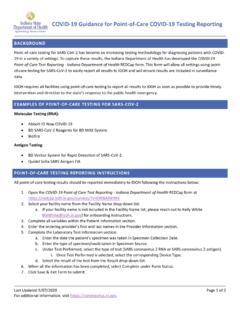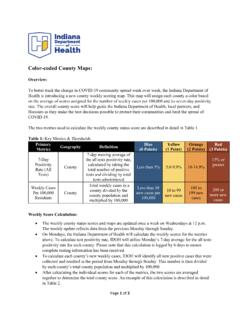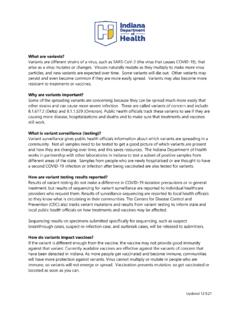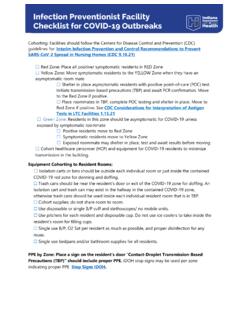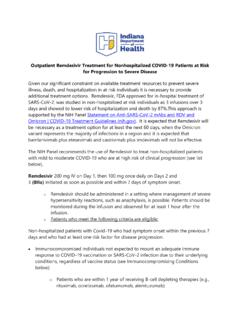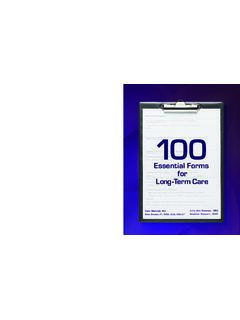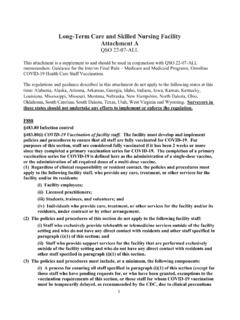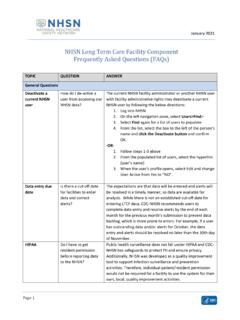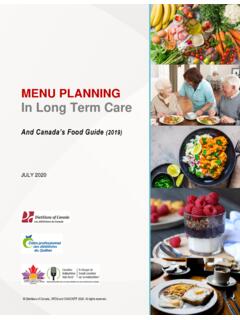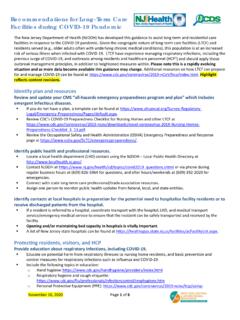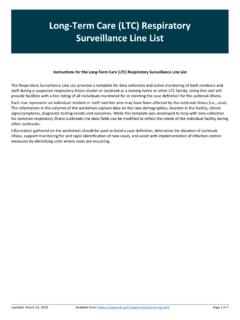Transcription of Long-term Care COVID-19 Clinical Guidance
1 Long-term care COVID-19 . Clinical Guidance INTRODUCTION. COVID-19 Clinical Guidance related to Long-term care facilities is based on the congregate setting, increased susceptibility of the elderly population to respiratory illness, current knowledge on the disease, infection prevention principles and prophylactic/ therapeutic options. COVID-19 is caused by SARS COV-2 virus. The virus spreads from person to person via respiratory droplets. People who are closer than 6 feet from the infected person are most likely to get infected. Individuals can acquire the virus by touching the eyes, nose, mouth with virus on the hands. COVID-19 can have varied manifestations ranging from asymptomatic to severe disease. Asymptomatic individuals can also transmit the virus, whether or not they develop symptoms later. The virus can mutate during the transmission and replication cycle to create a variant strain.
2 Variants could have differences with respect to their ability to transmission, disease severity, vaccine effectiveness, and response to therapeutics. How Coronavirus Spreads (CDC ). GUIDING PRINCIPLES. An individual is considered fully vaccinated two weeks after completion of the vaccine series, according to emergency use authorization or approval Guidance by Food and Drug Administration. Up to date on COVID Vaccination: Received additional dose and/or booster according to CDC Guidance , or fully vaccinated and not due for booster yet. Not up to date on COVID Vaccination: Unvaccinated or fully vaccinated, but not received a booster as recommended by CDC. Immunocompromised should follow the Guidance for unvaccinated individuals even after being fully vaccinated. Discuss with the resident's physician or specialist if you are unable to determine whether an individual is immunocompromised.
3 An individual with confirmed COVID-19 in the last 90 days needs to be tested only if symptomatic. The 90-day count starts from the day of diagnosis. The only exception to this is that staff may test as described in the staffing strategies section to determine if they can return to work after 7 days of isolation. Community criteria to discontinue isolation and quarantine do not apply for visitors and vendors to the nursing homes. They must complete the full 10 days before they can visit. Day of exposure or close contact is day 0 when counting the duration of the quarantine. Day of the start of symptoms is considered day 0 when counting duration of isolation. In asymptomatic cases, the day of the positive test is day 0. If they develop symptoms later, the day of the start of symptoms is day 0. 1 Last updated: Long-term care COVID-19 . Clinical Guidance Antigen testing is preferred (over PCR) if testing symptomatic HCP who had confirmed COVID-19 infection in the prior 90 days.
4 If tests are in short supply, they should be prioritized to diagnose infection. Follow this testing algorithm for residents to decide on the need for quarantine or isolation. Confirmatory testing should take place as soon as possible after the antigen test, and not longer than 48 hours after the initial antigen testing. o Considerations for Interpretation of Antigen Tests in Long-term care Facilities (CDC ). o Antigen Test Algorithm for Congregate Settings ( ). o Interim Guidance for Antigen Testing for SARS-CoV-2 | CDC o Testing in this document means a viral test (point of care /antigen or PCR/NAAT), not an antibody test. Strategies described under CDC Guidance may be used in case of a staffing shortage. CDC Guidance documents: o Infection Control: Severe acute respiratory syndrome coronavirus 2 (SARS-CoV-2) (CDC. ). o Interim Guidance for Managing Healthcare Personnel with SARS-CoV-2 Infection or Exposure to SARS-CoV-2 ( ).
5 O Interim Infection Prevention and Control Recommendations to Prevent SARS-CoV-2. Spread in Nursing Homes (CDC ). o QSO-20-39-NH REVISED (CMS ). o QSO-20-38-NH REVISED (CMS ). o Strategies to Mitigate Healthcare Personnel Staffing Shortages ( ). o Stay Up to Date with Your Vaccines | CDC KEY INDICATORS TO FOLLOW. Level of community transmission refers to the facility's county level of COVID-19 transmission. This metric uses two indicators for categorization 1. Total number of new cases per 100,000. persons within the last 7 days and 2. Percentage of positive diagnostic and screening nucleic acid amplification tests (NAAT) during the last 7 days), which can be found on the Centers for Disease Control and Prevention (CDC) COVID-19 Integrated County View site. If the two indicators suggest different transmission levels, the higher level is selected. CDC COVID Data Tracker QSO-20-38-NH REVISED (CMS ).
6 Routine testing frequency based on CMS NH testing guidelines QSO-20-38-NH REVISED (CMS ). PREVENT THE INTRODUCTION OF COVID-19 INTO YOUR FACILITY. Long-term care centers should take preventive measures every day to contain the spread of COVID-19 . Screening could be done by an individual or by implementing an electronic monitoring system in which an individual can self-report before entering the facility. 2 Last updated: Long-term care COVID-19 . Clinical Guidance Screen all healthcare personnel (HCP) each shift, and screen all visitors and vendors entering the facility for known diagnosis or symptoms of COVID-19 and for any history of being a close contact or exposed to COVID-19 positive or symptomatic person in the preceding 10 days. Visitors and vendors who have a positive viral test for COVID-19 , symptoms of COVID-19 , or meet the criteria for quarantine, should not enter the facility.
7 Post signs at the entrance instructing visitors not to visit if they have symptoms of COVID-19 . infection, known COVID-19 diagnosis or exposure to someone with COVID-19 in the preceding 10. days. Ensure sick leave policies allow employees to stay home if they have symptoms of COVID-19 . infection. Assess residents for symptoms of COVID-19 infection upon admission to the facility and implement appropriate infection prevention practices for incoming symptomatic residents. EXPOSURE. Exposure or close contact is defined as an interaction for a cumulative total of 15 minutes or more in 24. hours, fewer than 6 feet distance with a known COVID-19 case starting from two days before the onset of symptoms or positive test if asymptomatic. Follow the same Guidance if the exposure occurred during performance of an aerosol generating procedure, even if it is fewer than 15 minutes. Increase monitoring of residents with exposure including assessment of symptoms, vital signs, oxygen saturation via pulse oximetry and respiratory exam to identify and quickly manage serious infection.
8 O Interim Infection Prevention and Control Recommendations to Prevent SARS-CoV-2 in Nursing Homes (CDC ). From exposure to development of symptoms can take anywhere between two and 14 days. o COVID-19 Control Measures 410-IAC-1. HCP wearing proper PPE caring for a known COVID-19 case is not considered an exposure. All residents without a COVID-19 infection in the prior 90 days (irrespective of vaccination status). with close contact should be tested immediately, but not within 24 hours of exposure, and if negative should be tested again at 5-7 days after exposure. o Asymptomatic residents with close contact do not need to be tested or put in TBP if they had a confirmed COVID-19 infection in the last 90 days. o Residents that are up to date with COVID-19 vaccine upon close contact do not need to be in TBP if asymptomatic unless they are moderately to severely immunocompromised.
9 O Residents that are not up to date with COVID-19 vaccination upon close contact should be monitored in yellow zone and can be removed from TBP after 10 days if asymptomatic. Facilities could consider a test within 48 hours of planned discontinuation of TBP. These 3 Last updated: Long-term care COVID-19 . Clinical Guidance residents could be removed from TBP after 7 days if asymptomatic and had a negative viral test within 48 hours prior to removal from TBP. Refer to COVID-19 LTC Infection Control Guidance . Refer to Symptomatic Individuals and Known COVID-19 sections of this Guidance if symptoms occur or the resident tests positive for COVID-19 . o When a resident had known exposure, it should be discussed with facility medical director if candidate for post exposure prophylaxis. Interim Guidance for Managing Healthcare Personnel with SARS-CoV-2 Infection or Exposure to SARS-CoV-2 (CDC ).
10 Interim Infection Prevention and Control Recommendations for Healthcare Personnel During the Coronavirus Disease 2019 ( COVID-19 ) Pandemic (CDC ). Resources for Clinicians | (CDC ). Refer to staffing strategies section of this document for Guidance for staff with exposure. Staff must refer to CDC Guidance below for any update prior to any travel. o Domestic Travel During COVID-19 (CDC ). o International Travel During COVID-19 (CDC ). o COVID-19 Travel Recommendations by Destination (CDC ). SYMPTOMATIC INDIVIDUALS. Symptoms may appear 2-14 days after exposure to the virus. COVID-19 can have severe manifestations including organ system failure, need for hospitalization and can result in death. o COVID-19 Control Measures Guidance for symptomatic individuals is same irrespective of the vaccination status. Residents with symptoms of COVID-19 at any time should be tested immediately and be placed in TBP until they meet criteria for discontinuation of TBP, irrespective of their vaccination status.

